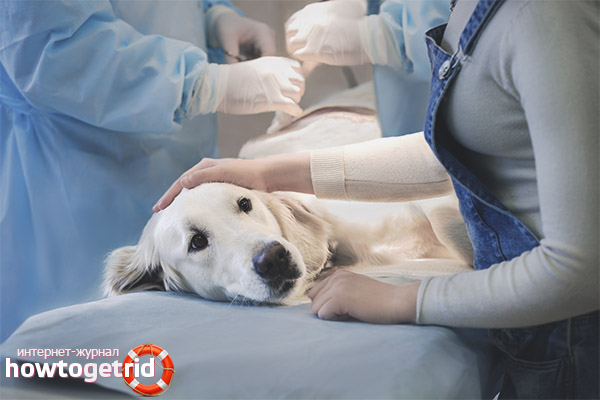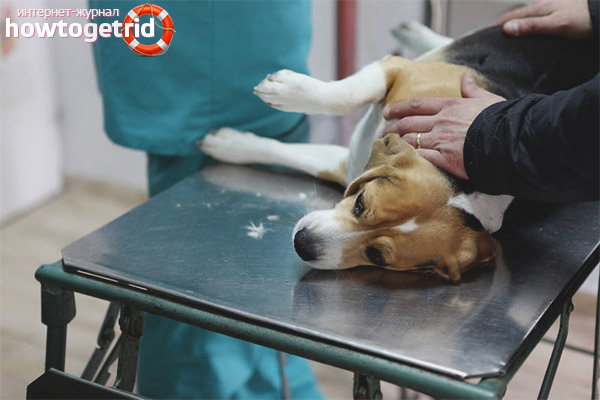The content of the article
In the modern world, many people who have pets consider it necessary to perform castration of animals. Most take this procedure for granted. However, there are owners who have been in doubt for quite some time about how expedient such a procedure will be, and agree to carry it out only as a last resort.
Sterilization and castration - what is the difference
Many people who are only distantly familiar with the concept of castration mistakenly believe that this procedure is intended only for males, and sterilization can be carried out exclusively for females. In fact, everything is somewhat different.
Sterilization of females involves ligation of the fallopian tubes, and the male sex is sterilized by ligation of the seminal ducts. In medicine, this procedure is called a vasectomy. The main advantage of sterilization is a humane attitude to the animal from a moral point of view, since all genitals that can continue to produce hormones in the usual rhythm of the animal are preserved. A pet that has undergone a sterilization procedure still needs to mate, but conception of offspring is not possible with this process.
But with regard to castration, this procedure is considered more radical than sterilization, since during its implementation the reproductive organs of the animal are completely removed. If females are neutered, this implies the complete removal of the uterus and ovaries, sometimes limited only to the ovaries. In the case of males, both testicles are amputated. Therefore, during sterilization, the sexual functions of the animal are partially violated, and during castration they are completely removed.
Why castrate dogs?
When considering this issue regarding female domestic animals, the conclusion is quite obvious. After castration of the female, the excited males will no longer flock around her threshold in packs, she will no longer rush from corner to corner, demanding mating, her behavior will become quiet and adequate, since the mating period will not be interesting to her. The dog will cease to expose itself to dangerous situations, and will not break "to freedom". On the physiological side, castration of a female individual also carries some positive aspects, for example, estrus stops, and with them the involuntary conception and birth of puppies ends, with which the owner will then be required to do something.
But with regard to the situation with males, castration is provided as a way to avoid many problems caused by aggressive behavior. The thing is that if the males do not mate for a long time, they will significantly increase the level of hormones. This leads to the fact that the dog begins to uncontrollably mark the territory, including household items, create difficult situations by jumping onto passers-by, and children in this case are no exception.
In the absence of mating, the male dog literally turns into an uncontrollable animal that does not respond to the owner’s commands. He can attack other males or begin the annoying pursuit of the female with a leak, up to the point that he will spend the night at her doorstep until he gets what he wants.The situation is aggravated by the fact that uncastered females after the estrus can still calm down in some way and return to normal behavior, but uncastrated males are in such an aggressive state of increased activity all year round.
Also, in addition to the physiological specificity of animals, which in most cases serves as a reason for castration, this procedure is performed on the basis of medical indicators. It can be various inflammatory processes or cancerous tumors in the genitals of the animal.
Positive aspects of castration
The procedure for castration of animals has such positive aspects:
- No matter what sex the animal has, its content in the apartment becomes much more convenient.
- After castration of males, the manifestation of aggression disappears from the side of the animal, and half of them ceases to mark surrounding things.
- Castrated males stop getting involved in fights on their own initiative, and become indifferent to other militant males.
- There is a gradual decrease in the sexual desire of the animal, and ultimately completely disappears.
- Castrated animals stop running away from their hosts and wandering around.
- Castration of animals of old age can prevent the appearance of cancer of the reproductive system.
- Since females are prone to uterine pyometra, it is necessary to simultaneously remove the uterus and ovaries during castration.
- This procedure protects the animal from the occurrence of infectious diseases of the reproductive system.
In a castrated animal, anxiety disappears, an increase in appetite and improved sleep is observed, and interest in active games and mischief is growing. The pet becomes calm and peaceful, attempts to gain leadership in the family eventually disappear without a trace.
After castration, only a correction of the nature of the pet takes place, and not its complete change. If the owner wants to change the behavior of the dog completely, he needs to engage in its training, to calculate the optimal level of physical activity and training for the animal. There are times when the nature of the animal is balanced upon reaching a certain age.
The disadvantages of castration dogs
Of course, like every surgical intervention, castration is characterized by the occurrence of some side effects and complications. The main disadvantage of this procedure is the occurrence of hormonal failure, which naturally then affects the general health of the pet.
The castration disadvantages include the occurrence of such complications as:
- Hyperthyroidism is a disease that causes a decreased thyroid function and a low level of the hormone that it produces.
- Cancer of bones - in most cases, it begins to develop in males after castration.
- Rapid weight gain - due to increased appetite that appears in the animal after castration, and a decrease in physical activity, overweight in the animal can cause him to have diseases of the cardiovascular system.
- Elderly neutered males very often suffer from behavioral abnormalities.
- After castration, males often change their coat, this is due to a deficiency of male hormones in the body, which makes their coat much softer.
The owner who intends to castrate his pet needs to know that our smaller brothers are much more difficult to tolerate anesthesia than people. Most veterinarians will confirm that the administration of animal anesthesia into the body is much more dangerous than the surgery itself. This is due to the fact that with insufficient anesthesia there is a risk of premature awakening of the pet, and in case of exceeding the dosage, cardiac arrest is not excluded.
How does the operation
To perform castration, the animal is given general anesthesia, as a result of which it falls asleep, and the veterinarian can safely proceed to the procedure. As preparatory measures, perform the following actions:
- place the pet on a sterile operating table;
- general anesthesia is administered;
- remove wool from the place where the operation will be performed;
- disinfect the shaved area of the body.
Castration of a male represents several sections on the scrotum, which are made by a veterinarian in order to pull the spermatic cord. After the cords are pulled, the testes are quietly amputated. The wound that forms at the site of amputation must be sprinkled with a special powder - Tricillin, since it prevents complications after removal. Castration in males lasts no more than ten minutes, there is no need to remove the seams after such an operation, since the incision site is sutured with absorbable threads.
The castration process of a female is much more complicated than that of a male. This is because the veterinarian needs to get inside the body of the animal. The process of penetration is performed by cutting the groin of the female. Through this incision, the necessary genitals are removed. It can be just ovaries, or paired with the uterus. The duration of such a procedure is about forty minutes. At the end, the doctor performs suturing of the animal to the site of the incision or even blanket - if necessary. This is to prevent the dog from accessing the damaged area.
Age suitable for castration
For castration of males, age restrictions are provided. The procedure can be performed no earlier than it reaches the age of six months. If castrated before the recommended period, it is possible to stop the growth and physical development of the animal.
Females are recommended to be neutered before their first estrus begins, approximately six to nine months old. With timely and proper castration, you can protect the female from the further appearance of breast tumors.
Postoperative Animal Care
In the first few hours after surgery, when the condition of the animal is still rather weak, involuntary urination is characteristic. This should be foreseen before the start of the procedure and stock up with absorbent disposable diapers that are useful both for transporting the animal and for its stay in the home environment, the use of oilcloths is not ruled out.
Having delivered the animal directly home, it must be placed in a suitable warm place. In no case should you place the dog after surgery near a window, battery or where there is a draft.
Until the pet is completely restored after the operation, the owner must follow the general indicators:
- A slight decrease in the pulse in the animal after the operation is allowed, the main thing is that it be even.
- The breathing should also be even and calm, there should be no delay or rapidity.
- The mucous membranes should have a natural color if they turn pale or become cyanotic - this is the first sign that the animal has problems.
The first day after the operation, the owner must shift his pet from side to side every hour. Wet bedding should be changed immediately, otherwise the animal may freeze.
Video: castration of dogs and cats - pros and cons











Submit